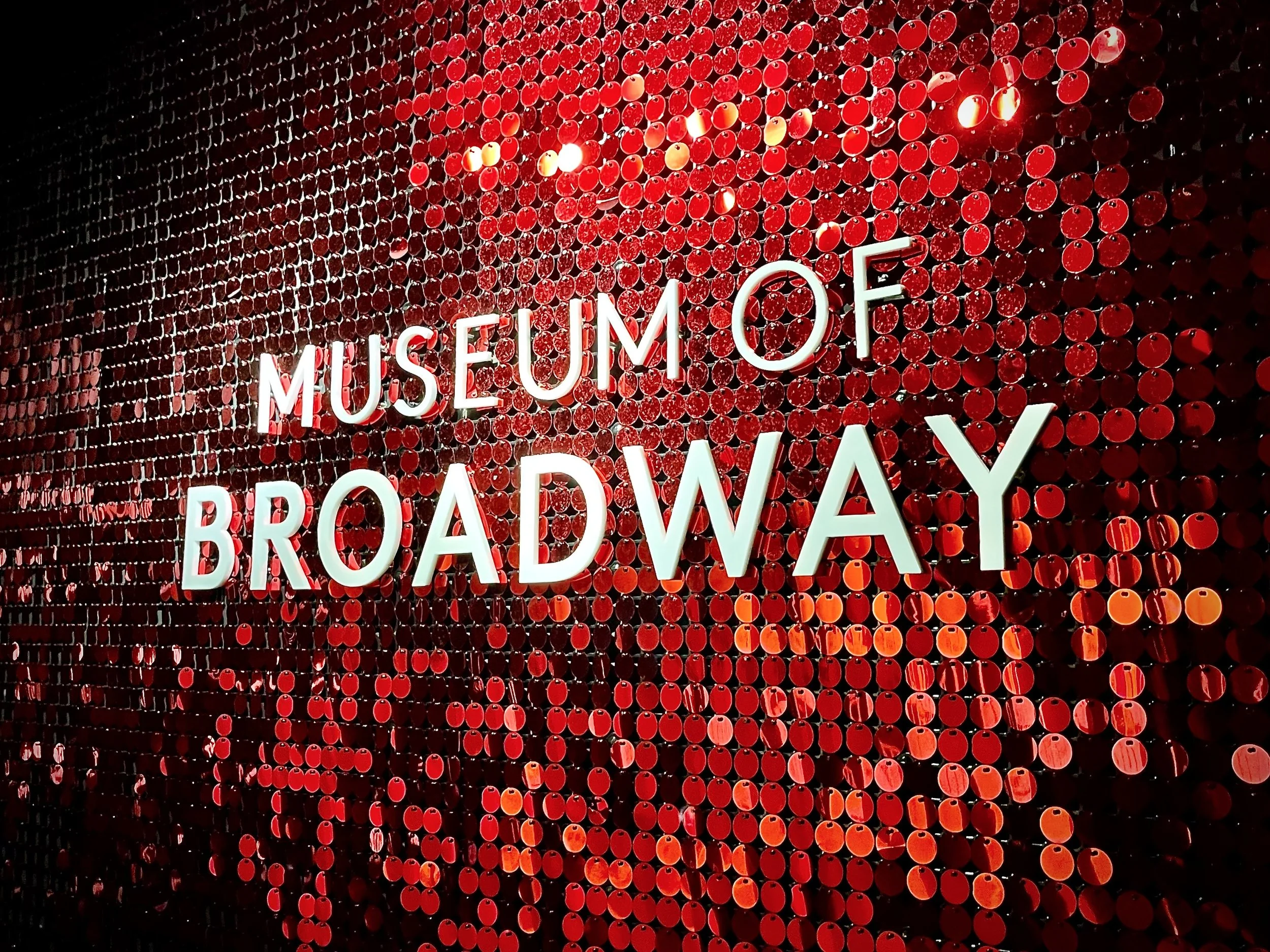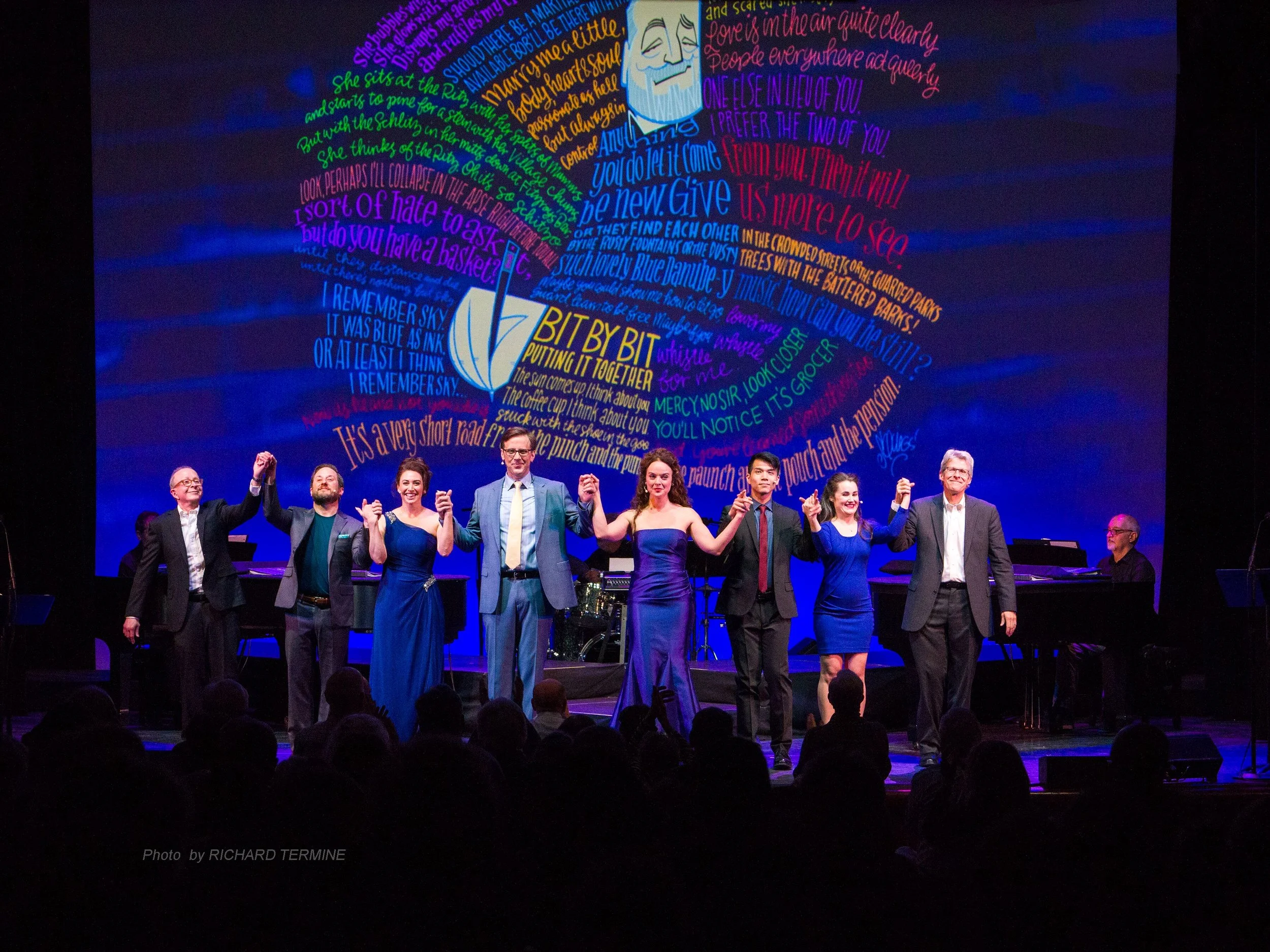The Last Musical - Review of Sondheim's HERE WE ARE
Above: Photo by Emilio Madrid.
October 22, 2023
By Brian Taylor
‘‘Why are you here?”
Early 2012, four years after the Public Theatre premiere of Road Show, which took a decade to reach fruition, word arrived that 81-year-old Stephen Sondheim was working on something new in collaboration with playwright David Ives. It instantly became the most anxiously anticipated show of the modern era, and nearly two years following Sondheim’s death at the age of 91, here it is.
In his review of the 1981 opening of Merrily We Roll Along, Frank Rich wrote, “to be a Stephen Sondheim fan is to have one's heart broken at regular intervals.” The degree and nature of that heartbreak upon experiencing Here We Are, which combines two surrealist films by Spanish director Luis Buñuel, 1972’s The Discreet Charm of the Bourgeoisie and 1962’s The Exterminating Angel, will vary depending on one’s expectations.
Photo by Emilio Madrid.
Director Joe Mantello and Ives, long stymied by the composer’s infamous (and self-admitted) procrastination and writer’s block, then the COVID pandemic — which seemed to amplify and intensify the central themes of the piece — were left with an unfinished score upon Sondheim’s passing. The first act, based on The Discreet Charm of the Bourgeoisie, in which a group of wealthy characters search for a place to dine, was musically ready.
But Sondheim never cracked the nut of the second act, The Exterminating Angel, in which a group of diners find themselves unable to leave the dinner party. Nonetheless, Ives and Mantello had already secured Sondheim’s blessing to forge ahead as is, finding dramatic metaphor in the lack of songs once the characters become paralyzed.
What has arrived at The Shed, a sleek Off-Broadway black-box theatre, is a star-studded, state-of-the-art evening of edgy, intelligent satire. The cast is superb, the set and costume design by David Zinn out-does much of what passes on Broadway anymore, and Ives and Mantello are at the top of their game.
“It Is What It Is”
Those holding their breath for Here We Are to reveal a late-career evolution, some new compositional style, or even a masterpiece to eclipse, say, Sweeney Todd, grandly revived uptown at the Lunt-Fontanne Theatre, set themselves up for disappointment. Don’t expect an instantly classic song poised to supplant beloved standards such as “Being Alive,” “Send In the Clowns,” or “No One Is Alone.”
But, let’s remember, in his New York Times review of Passion (1994), David Richards wrote, “the boldness of the enterprise never quite pays off. The musical leads an audience right up to the moment of transcendence but is unable in the end to provide the lift that would elevate the material above the disturbing.”
In the same newspaper, of the earlier Assassins, Frank Rich asserted its “potential is unfulfilled,” writing that “high intentions, intermittently realized, hardly seem like achievement enough.” Of the score, that its “stop-and-go gait and sometimes collegiate humor … never cohere[s] into a fully realized score that builds in cumulative effect.”
Both works are now widely revered.
It’s understandable why Sondheim was drawn to Buñuel’s films: opportunities for song based on idiosyncratic characters in highly specific situations, and a broad canvas for continuing lifelong experiments. The opportunity to take something abstract, nonsensical, yet filled with meaning, and fashion it for the stage by stretching the medium of musical comedy.
And with the subject of gastronomy being prominent, he certainly seemed to relish playing with food-and-drink-related rhymes, and French and Italian words (“sole meunière” and “Camembert”).
Arguably the final entry into the canon of twentieth century American musical theater, when it truly soars, Here We Are succeeds as a thought-provoking work of art, sardonic and lyrical. At times, the score suggests a ‘60’s TV sitcom scored by Stravinsky. In others, Ravel’s opera L’heure espagnole and Bernstein’s Trouble in Tahiti seem to be forbears. The first act may eclipse everything else in the current season, in terms of artistic aspiration and precision of craft. The second act, while a highly accomplished effort, shall remain forever incomplete.
Entering the mysterious blob that is The Shed, joining a blob-like queue (snaking through McNally-Jackson’s shelves of books by, about, and collecting the lyrics of Sondheim, then ascending up several escalators), it feels like you’re at a modern art museum on line for the latest Infinity Room. A thrust stage dominates, with a crisp, shiny white decor straight out of Hudson Yards. We are in the home of the extremely rich; the housekeeping staff (a hilarious Tracie Bennett and Denis O’Hare) polish and shine.
A brief overture — sprightly and angular — hints at Copland-esque Americana, and ends quickly, with an ironic zinger that will be familiar to Sondheim’s audiences. The opening scene swiftly establishes the approach to adapting the Buñuel material — these are contemporary characters. Zinn’s witty costumes pop. Bobby Cannavale, clad in maroon velvet tracksuit, and Rachel Bay Jones play tycoon Leo and decorator Marianne Brink. Buñuel’s nighttime opening is transplanted to the brunch hour. A slyly comedic Steven Pasquale, as Raffael Santello Di Santicci, the Ambassador of fictional Miranda, accompanied by talent agent Claudia (Amber Gray) and plastic surgeon Paul Zimmer (Jeremy Shamos), arrives at the Brink abode expecting brunch, to their would-be hosts’ mystification.
They collectively decide to hit the road and find a place to eat. The peppy orchestra revs its engine under the driving baton of Alexander Gemignani. A zippy, cartoony instrumental phrase acts as a psychological palette-cleanser, and a quick lobotomy for the audience. Then, a bouncy vamp from the same sketchbooks as “The Little Things You Do Together” contrasts with a more dissonant, sighing groove, as the story cuts cinematically between conversations. As Marianne sings: “What a perfect day / On a day like today / What could ever go wrong?” the musical texture is underpinned by the motoric rhythm of woodblock, shaker, and bongos punctuated by triangle.
We meet Fritz (Marianne’s nonconforming sibling), a socialist Pollyanna, played with downtrodden accuracy by Micaela Diamond, who warns of coming revolution: “that’ll be the end of the world / Your world.” The number teems with energy, rhymes ‘Lamborghini’ with ‘vodka-tini,’ and contains fleeting glints of brilliance. But it wraps up too promptly, its button bringing us to Cafe Everything. A musical toast to brunch is interrupted when the waiter (O’Hare, again) arrives to take the order.
In a comedic interrupted waltz, it emerges that alas, Cafe Everything is out of everything. The show is at its best in detailed, understated sendup such as O’Hare’s browbeaten waiter, and also in the following scene (at Bistro á La Mode), Tracie Bennett’s steely, fatalistic waitress who delivers a stand-out solo (“Everything now is what it is…”), a soaring torch-song that asks “Does anyone know what they want?”
Roger Ebert noted, “the joke in The Discreet Charm of the Bourgeoisie is the way Buñuel interrupts the meals with the secrets that lurk beneath the surface of his decaying European aristocracy: witlessness, adultery, drug dealing, cheating, military coups, perversion and the paralysis of boredom.” The plot thickens, much as in Discreet Charm…, with a shady cocaine deal and an illicit love affair (which inspires the uncharacteristically cringey rhyme of ‘bed’ and ‘head’), as well as some invented threads fleshing out the narrative.
Jin Ha and Micaela Diamond in Here We Are. Photo by Emilio Madrid.
Francois Battiste as military Colonel, and Jin Ha, as his noble lieutenant, promptly interrupt the proceedings (again, vaguely similar, but streamlined from Buñuel). The musical high point of the show, Sondheim supplies the character of the soldier with his most romantic melody, torn from the pages of Into the Woods or Passion, as he relates a dream about a mysterious girl whose “name was like music.” Then as he and Fritz meet eyes, it blossoms into a tender love duet (with Sondheim-ian asides, “then my mother came in”). The moment barely takes flight before being interrupted.
The jaunty opening vamp returns with fun variances and interruptions, until it ultimately breaks down into a dissonant clash, like a head-on collision, the musical equivilent of ?!?!. Sondheim also supplies a flirtatious song for Pasquale, “Marianne,” an insincere tango (an ironic echo of West Side Story’s “Maria,” perhaps).
David Hyde Pierce as a bishop in Here We Are. Photo by Emilio Madrid.
Finally, David Hyde Pierce, as a bishop, arrives looking for a job (“I’m a terrible priest”). His light-as-air, droll turn as a hapless clergyman proves to be the heart of the show. He sings one of the show’s most satisfying numbers, the middle section of which is a musical highlight as he grapples with God, purpose, and a fetish for women’s shoes.
“It’s the end of the world”
The idea to combine the two films into a two act piece was clever. But, the score dissolves permanantly into underscore early on in Act Two, as the characters decide to settle in for the night. It’s too bad Sondheim’s ink ran out when it did, leaving a few moments, poignantly, still needing his input.
At one point, Marianne asks the Bishop to explain the meaning of life, or perhaps just “being,” in exchange for holding her shoes. The bishop’s ensuing reply cries out to be a song; Ives’s text is clearly laid out in rhythmically balanced form, as if he were handing Sondheim a song’s ingredients on a platter. I imagine the composer mulling the weight of what he should write for this moment. Perhaps, he was hampered by déjà vu. Hadn’t he already written a song about being alive?
Tension between classes — the rich versus “the help” — is an overarching theme. The various servants that hold the evening together are played with comedic tour de force by O’Hare and Bennett. O’Hare’s series of characterizations steals the show and he, too, could have supported an 11 o’clock number.
Given Sondheim’s absence, the man of the hour, as often, is orchestrator Jonathan Tunick. He has taken what were undoubtedly Sondheim’s trademark pianistic sketches and constructed a distinctive sound, edgy and zany. With remarkable variety of color from such economical forces, he liberally deploys saxophones and percussion, finding choice moments for warm strings, as in the Soldier and Fritz’s love music, along with gratifying countermelody for the powerful French horn. More than mere technician or craftsman, Tunick is an artist — an essential voice in the creation of the piece.
Photo by Emilio Madrid.
Frank Rich, in “The Final Sondheim” for New York Magazine, quotes a letter from Ives to Mantello, lamenting that Sondheim “wants to seem to be writing a musical but doesn’t want to actually write a musical.” Of course, he wanted to be writing a musical, that’s what he did, how he processed the world. And the Buñuel provided the ultimate framework on which to hinge the language of musical comedy that he spent a career pursuing.
Sondheim, a famous lover of puzzles, spent his final decade attempting to solve the ultimate puzzle — to musicalize an experiment in artistic limits and possibilities. Perhaps he always knew he might not live to complete the challenge. It was his Everest, an intellectual and artistic mountain to climb at his well-earned leisure. As he wrote in a letter to his collaborators, paraphrasing Shakespeare, “the trying is all.”
***
Here We Are plays at The Shed through January 21, 2024.









